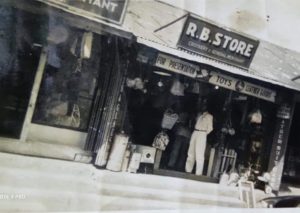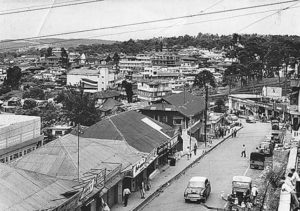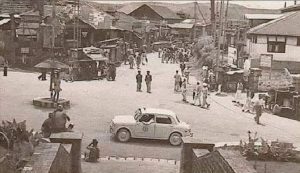Jnanendra Das ushers the new year by revisiting the possible histories and stories behind the names of Shillong’s prominent localities, after years of research collated by Sarad Bawri.
 A stroll through Shillong unveils localities with names that are both whimsical and historically significant. What’s in a name, you ask? These names often reveal much about a place’s geography, history, and culture, offering a glimpse into its past and defining features.
A stroll through Shillong unveils localities with names that are both whimsical and historically significant. What’s in a name, you ask? These names often reveal much about a place’s geography, history, and culture, offering a glimpse into its past and defining features.
Each locality’s name tells a story—some lighthearted, others deeply rooted in tradition. Together, they reflect Shillong’s vibrant mosaic, shaped by Khasi heritage and colonial influences, among others. What better way to begin the new year than to trace the possible origins of the names of our neighbourhoods?
What began as a casual interest evolved into a dedicated two-year journey of discovery and validation. Sarad Bawri, a Shillong-based businessman, meticulously researched and documented the origins of these names.
“Have we ever wondered how our localities got their names? Some have fascinating origins, while others stem from more mundane or pedantic beginnings or lack verifiable authenticity. Uncovering these stories makes for captivating reading. That said, a caveat is necessary—though extensively researched and vetted by renowned historians, some origins remain open to interpretation or have been altered over time,” says Bawri.
The Roots
 Before we dive into this list, do you know how Shillong got its name?
Before we dive into this list, do you know how Shillong got its name?
The name is believed to come from the Khasi deity, “U Blei Shyllong”, who is thought to reside on the peak overlooking the city, eponymously called Lum Shyllong.
To bring order to this exploration, let’s delve into Shillong’s localities alphabetically.
A – Arbuthnot Road: Named after J.C. Arbuthnott, Deputy Commissioner of Shillong in 1897.
Alugodam: Named after godowns maintained by merchants like Hardeodas Bawri for storing potatoes.
B – Barik: During World War II, the present-day PWD premises used to be the “Barrack” for the American soldiers. Barrack eventually evolved into Barik in the local dialect.
Beat House: The Laitumkhrah Police Beat House, (now Police Station) is situated here. The  beat is the territory that a police officer is assigned to patrol.
beat is the territory that a police officer is assigned to patrol.
Bishop Cotton Road: Named after the Missionary who acquired the land for the All Saints’ Church in 1872.
Bivar Road: Named after Col. Henry S. Bivar, Shillong’s first Deputy Commissioner in 1864.
D – Dhankheti: Meaning “paddy cultivation,” it recalls the area’s agricultural history. Dhan literally means paddy, and kheti means field or cultivation.
Dhobi Ghat: Literally, the place of washermen. It is the place where the washermen used to clean clothes.
Don Bosco: Evidently because the Don Bosco institutions are situated here. Also known as Don Bosco Square, owes its name to the statue of Don Bosco, an educator and a friend of youth. The statue bears testimony to the academic ambience of schools and colleges started by the Salesians in Shillong.
F – Fire Brigade: Named after the fire services stationed in the area.
4th Furlong: Earlier, this place used to be the 4th Furlong (an eighth of a mile, 220 yards) for horse racing events.
G – Golf Links: Known for its iconic 18-hole golf course. Earlier it had 9 holes.
H – Hopkinson Road: Named after Col. Henry Hopkinson, Commissioner of Assam in 1861.
Hynñiewmer: Hynñiew in Khasi means seven. New in Newmer stands for seven, hence, the seventh mile measured from the Secretariat.
I – Iewduh: Meaning “market likely to close soon”. Iewduh or Bara Bazar was the last market day of the Khasi 8-day week cycle. (Literally, Iew=bazar, duh=likely to close down soon).
Iewmawlong: Originally called Laban Bazar, the market used to be held on the 3rd day of the Khasi 8-day week.
J – Jail Road: Road leading to the prison.
Jinkieng: Literally the “bridge”.
Jylli Shop: Named after a lady named Jylli, who had her tea shop there which eventually became the name of this place.
K – Kachari: Kachari in many Indian languages means court. The area where the courts were located has evolved to be named as Kachari
Keating Road: Named after Col. Richard Harte Keatinge, the first Chief Commissioner of Assam (from 7th February 1874). Since Shillong was then the capital of the Province of Assam, this name was dedicated to Col. Keatinge who governed from there.
Khyndai Lad: Refers to a meeting point of nine roads or leading to nine roads. Namely, Soso Tham Road, Keating Road, G.S. Road, Police Bazar, the road to the MUDA parking lot, Quinton Road, Jail Road, Oakland Road, and the steps leading to the erstwhile State Assembly.
L – Laban: The first village encountered on the journey from Cherrapunjee, which later got clubbed with other adjoining villages, and the entire area later came to be known as Shillong. After the British established their new capital in Shillong in the 1860s, they identified Laban, then a small farming village, as the ideal location for their Indian government servants, to settle in. Thus, Laban became a more cosmopolitan locality, with a mixed population.
Lachumiere: Derived from the French word for ‘little cottage’, which was the summer residence of the former nawab of Dacca (now Dhaka).
Laimer: Lai stands for the Khasi number 3. The third mile measured from the Secretariat came to be known as Laimer.
Laitumkhrah: Literally, “lait” i.e., “way to/go to”, “Umkhrah” river. So, way to Umkrah river.
Lawsohtun: Law stands for the forest in Khasi. The forest named after the Sohtun clan became Lawsohtun.
Lummawrie: Lum means hill. The hill was named after the Mawrie clan, so Lummawrie.
Lumpyngngad: Like Lummawrie, meaning the hill with nice air
Lumparing: Literally, steep hill.
M – Mawblei: In Khasi, Maw means stone and Blei stands for God. So literally, the stone of God is believed to exist there.
Mawlai: Maw means stone Lai in Khasi means three. The third-mile milestone measured from the Secretariat stands there, hence Mawlai.
McCabe Road: This place is named after Robert Blair McCabe, Inspector General of Police, who died during the great earthquake of 12 June 1897.
Mission Compound: Settlement named after the Welsh Presbyterian Mission church there.
Motinagar: Named after freedom fighter Motiram Barua, who later became an MLA and owned large tracts of property there.
Motphran: Etymologically, Mot means pillar, and Phran is the Khasi word for France. The “Monument of France” which is locally known as “Motphran” was erected in memory of the 26th Khasi Labour Corps who served under the British in France during the First World War. They were porters who had carried arms, ammunition and other essential items for the British soldiers during the First World War.
N – Nongkseh: The Khasi root word Nong means village and kseh means the tree species Pinus kesiya (the local Pine tree). So the village with the pine trees came to be known as Nongkseh.
Nongrimbah: Nong means village and Bah in Khasi means big, indicating a large settlement or village.
Nongthymmai: Means “new village”.
O – Oxford Hill: Named after the Oxford Mission which had several houses on the hill.
P – Paltan Bazar: The English word “platoon” became “paltan” in many Indian languages like Hindi and Urdu. This area used to be an Army camp, i.e., the area used to accommodate the Platoon or “Paltan”.
Pine Mount Ridge: Eponymously named after the school of this name.
Police Bazar: Because the main Police station was situated here.
Polo Ground: The Polo games used to be held at the grounds here.
Pynthorbah: Pynthor in Khasi means arable land and bah as we already know means big. Hence, a large cultivated land.
Pynthorumkhrah: Pynthor-Umkhrah formed by Khasi root words, meaning a cultivated land near the Umkhrah river.
Q – Qualapatty: The word Gwala means cowherds in languages like Hindi. This area was originally populated by cowherds. Gwala became quala in the local dialect and the area became Qualapatty.
Quinton Road: Named after James Wallace Quinton, Chief Commissioner of Assam in 1889.
S – Sawlad: Literally leading into four (saw) roads.
Shyiap: Shiap means sand in Khasi, and since a lot of sand mining happened in the locality, hence the name.
T – Temple Road: The road leading to the temple of FreeMasons.
Thana Road: Named for its proximity to the police station or thana in common language.
U – Upland Road: Possibly named for its elevated position.
W – Wahingdoh: To hang (Wah) inside the house (їing) the meat (Doh). This house could have possibly been of S. Brilliancy Lyngdoh Nongpyuir.
Z – Zigzag Road: Known for its winding nature.
Other locality names that did not find mention in the list above, couldn’t be traced to their origins. In case our readers can trace the origin of any locality names you can reach out to Sarad Bawri ([email protected]) or write to us at sundayshillong@



